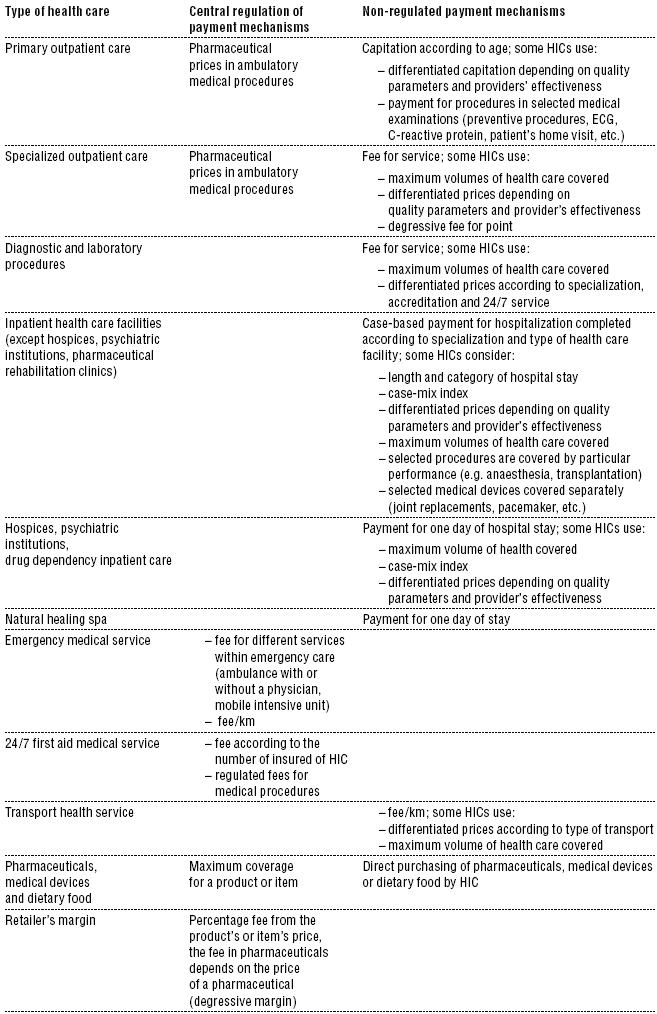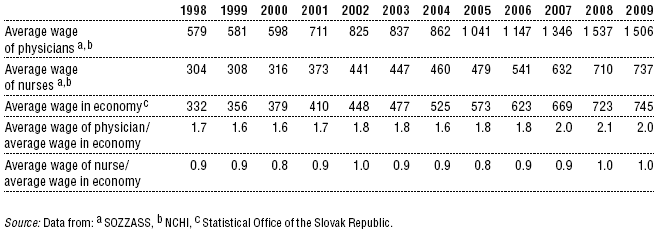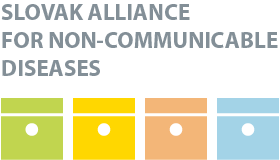—
HPI Network > HPI - Health Policy Institute > Health System in Slovakia > 3. Financing > 3.7 Payment mechanisms
3.7 Payment mechanisms
Thursday, 05. May 2011, 0:49 — HPI
| << PREVIOUS
3.6 Other financing |
Introduction – Organization – Financing – Resources – Provision – Reforms – Assessment – Conclusions – Appendices |
NEXT >>
4. Physical and human resources |
Providers are paid according to an individual contract, which determines the amount, the nature and quality of services as well as the payment system. A given health insurance company may have negotiated different prices for different providers, which is particularly the case in inpatient care. Outpatient health care providers and providers of laboratory diagnostics operate with uniform prices. A health care provider can be paid higher prices, when the quality or effectiveness criteria in the contract are met; or paid lower prices when these criteria are not met.
3.7.1 Paying for health services
In the past, payment mechanisms and prices for health services were determined at the central level by the Ministry of Finance and the Ministry of Health. Since 2003, health reform has brought a gradual deregulation of the majority of prices and payment mechanisms. At present, the Ministry of Health only sets maximum prices for pharmaceuticals, medical devices and dietary foods in outpatient care; 24/7 first aid medical services; social services covered by public resources; induced abortions; and preventive care for active athletes below 18 years of age. The prices of emergency medical services are fixed. Prices and payment mechanisms for other health services are subject to contractual conditions as negotiated between health insurance companies and health care providers. Payment mechanisms were slow to follow the deregulation of prices. Today’s payment mechanisms (see Table 3.10) represent mostly just a modification of the original models.
Table 3.10: Payment mechanisms in health care purchasing in 2010

Payments for primary outpatient health care are a combination of capitation and fees for certain medical procedures not covered by the capitation but included in SHI benefits, such as preventive care and some costly examinations like C-reactive protein, ECG or colorectal cancer screening. The amount of an insured person’s capitation payment is age-dependent and generally equal for all health care providers. The recent implementation of differentiated capitation payments, based on certain quality and effectiveness criteria, is an exception. The system of capitation payment is an advantage for health insurance companies in terms of controlling their costs because it allows them to know the exact cost in advance. On the other hand, it does not motivate GPs to perform more costly medical procedures since they bear all the risk.
Specialists in outpatient care are paid on a fee-for-service basis. Each medical procedure has an assigned number of points, and health insurance companies negotiate the fee for one point (point value) with health care providers. Since 2005, the numbers of points, issued by the Ministry of Health and originally representing a fixed payment mechanism, do not represent an obligatory mechanism for health insurance companies. The insurance companies and providers are free to negotiate any payment mechanisms in contracts. Despite this, all health insurance companies have been using the points system. With this system, the specialists have an incentive to treat patients, but the system may not motivate to cure patients. This makes it difficult to control the volume of the services provided and thus the costs. Therefore, most health insurance companies negotiate a maximum volume of points to be reimbursed. If the health care provider exceeds the negotiated volume, the health insurance company does not have to reimburse the extra points. Whether the health insurance company will cover the costs or not depends on the negotiated contract. Some health insurance companies have introduced differentiated point values, depending on the provider’s quality and effectiveness. One health insurance company applies a differentiated point value, depending on the number of medical procedures performed in a given month. In this system, the point value decreases with the increase in number of procedures performed (degressive point value). Pharmaceuticals given to a patient during outpatient visits are reimbursed to a physician in addition to the capitation and fee-for-service payments by the insurance companies. The positive list of reimbursed pharmaceuticals as well as the reimbursement level are defined by the Ministry of Health (see section 2.8.4 Regulation and governance of pharmaceuticals).
The prices for diagnostic and laboratory procedures are also deregulated, but all the health insurance companies still use the points system. However, health insurance companies apply volume limits for providers of diagnostic and laboratory tests as well as differentiated fees according to specialization, accreditation and for 24-hour health services.
Medical procedures in inpatient care are paid using a case-based system. The health insurance company reimburses the hospital for a completed hospitalization of a patient according to the specialization and type of health care facility. Prices for completed hospitalization are contracted on an individual basis between health insurance companies and hospitals. Some health insurance companies set the prices depending on the length of a hospitalization; a patients’ case-mix index, which takes into account severity of the hospitalization; and on quality and effectiveness parameters. In order to control the costs, some health insurance companies negotiate a maximum volume of reimbursed health care services. Some procedures, costly pharmaceuticals and medical devices such as artificial joints and pacemakers are reimbursed separately from the hospitalization fee.
The prices in chronic and psychiatric health care, as well as balneal treatment are set for one day of stay and are subject to negotiations between a health care provider and a health insurance company.
The 2004 reform changed the payment mechanism for emergency medical services. Health insurance companies pay a fixed price per ambulance car plus mileage, both determined by the Ministry of Health. Payments for 24/7 first aid medical services are regulated on a central basis, covered by health insurance companies according to their market share.
Transport for receiving a health service is priced by mileage; some health insurance companies set prices according to the type of transport or maximum volume of health care covered.
Pharmaceuticals, medical devices and dietary foods are included in hospitalization costs. In the case of expensive medical devices, health insurance covers the price above the limit set for hospitalization. In ambulatory care, these services are covered by SHI when prescribed by a contracted physician. The maximum amount to be covered is set by the Ministry of Health. The health insurance companies must reimburse the costs for pharmaceuticals to the pharmacy where the patient received his or her prescription, or to a health care provider if the patient was administered a pharmaceutical in ambulatory care. In case of non-contracted care, a health care provider can charge the patient directly. The tariffs for non-contracted care must be published by the provider. If an insured person opts for a non-contracted health care facility, he or she must approach his or her health insurance company for pre-authorization. In case of an approval, the costs will be reimbursed afterwards, either fully or up to a certain amount.
Whether payment mechanisms will develop further depends on the negotiations between health insurance companies and health care providers. Both parties have an incentive to improve the mechanisms, so that the systems better reflect the quality of provided care and its intensity. In ambulatory care, health care companies are expected to apply mechanisms to improve the quality and effectiveness of the health care provided.
Implementation of protocols into contracts with health care providers, resulting in a fee for health outcome could be the most important development. Protocols should ensure standardization of processes as well as good quality and effective health care for those insured. The use of outcomes will motivate health care providers to improve the health of patients. Introducing a more sophisticated DRG model could more accurately reflect costly hospitalizations. This will require a long preparatory process as there is a lack of data on the severity of hospitalization cases.
3.7.2 Paying health care professionals
Private physicians in ambulatory care are financed by earnings from contracts with health insurance companies, as well as by earnings from direct payments by patients for services not covered by SHI. The earnings cover all the expenses for outpatient care provided as well as the salaries of health care personnel.
Prior to 2005, health care personnel in inpatient care facilities were paid according to a uniform system for public service staff. Since January 2005, the financing of personnel in inpatient health care facilities has changed. Employees are hired/fired according to the Labour Code. The amount of salaries depends on collective agreements between the employees’ representatives (trade unions) and the employers’ representatives. These agreements are decentralized, so salary levels vary across the country.
The growth of average monthly salaries in health care during the past 10 years shows significant fluctuations (see Table 3.11). Until 2000 and in the period 2002–2005, this growth was less than 5% per year, that is, less than the average monthly salary in the Slovak economy. In 2000–2002 and since 2006, growth was more rapid than average salary growth. In 2006 and 2007, the salaries of physicians increased by more than 17% (2.3 times more than average salaries) and salaries of nurses increased by 25% (3.3 times more than average salaries).
Table 3.11: Average wage of physicians and nurses, and average wage in Slovakia (€)

News
The amendment of the Decree on emergency medical service
Health insurance companies returned over 400 thousand €
The HCSA received 1,647 complaints last year
A half million people will earn more
Most of public limited companies ended in the black
Debt of hospitals on premiums has grown to nearly € 105 MM
Slovak health care may miss € 250 million next year
Profits of HIC amounted to € 69 mil. last year
Owners of Dôvera paid out money but did not paid taxes
Like us on Facebook!
Our analyses
- 10 Years of Health Care Reform
- New University Hospital in Bratislava
- Understanding informal patient payments in Kosovo’s healthcare system
- Analysis of waiting times 2013
- Health Policy Basic Frameworks 2014-2016
- Analysis of informal payments in the health sector in Slovakia
- Serbia: Brief health system review
developed by enscope, s.r.o.
